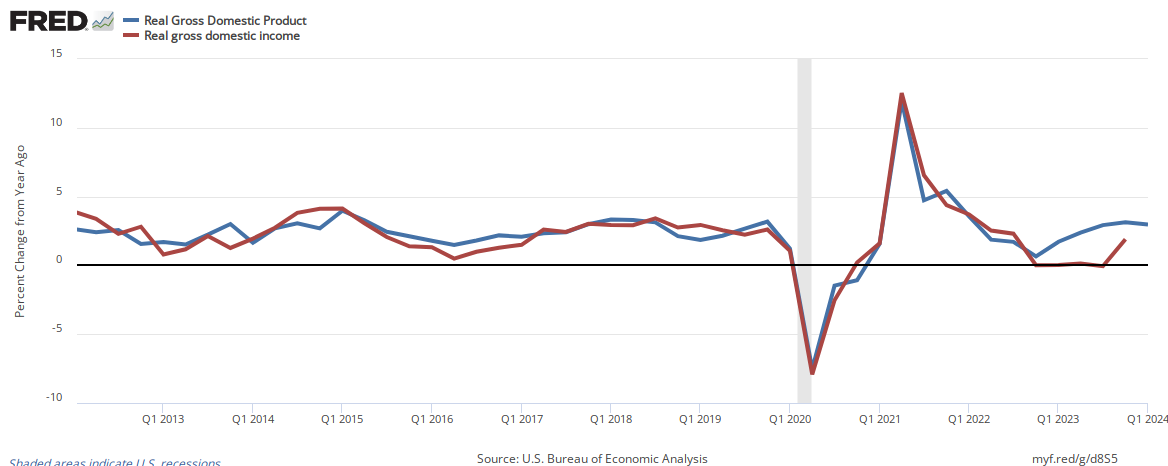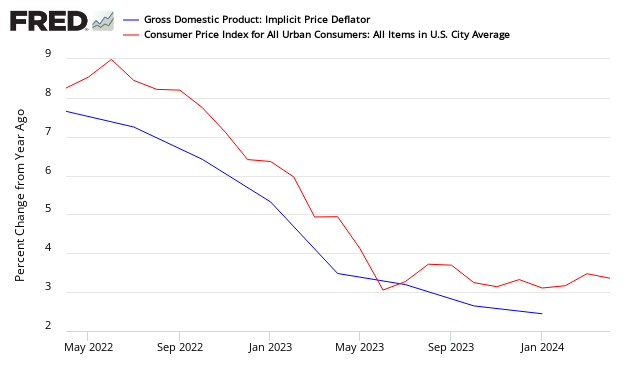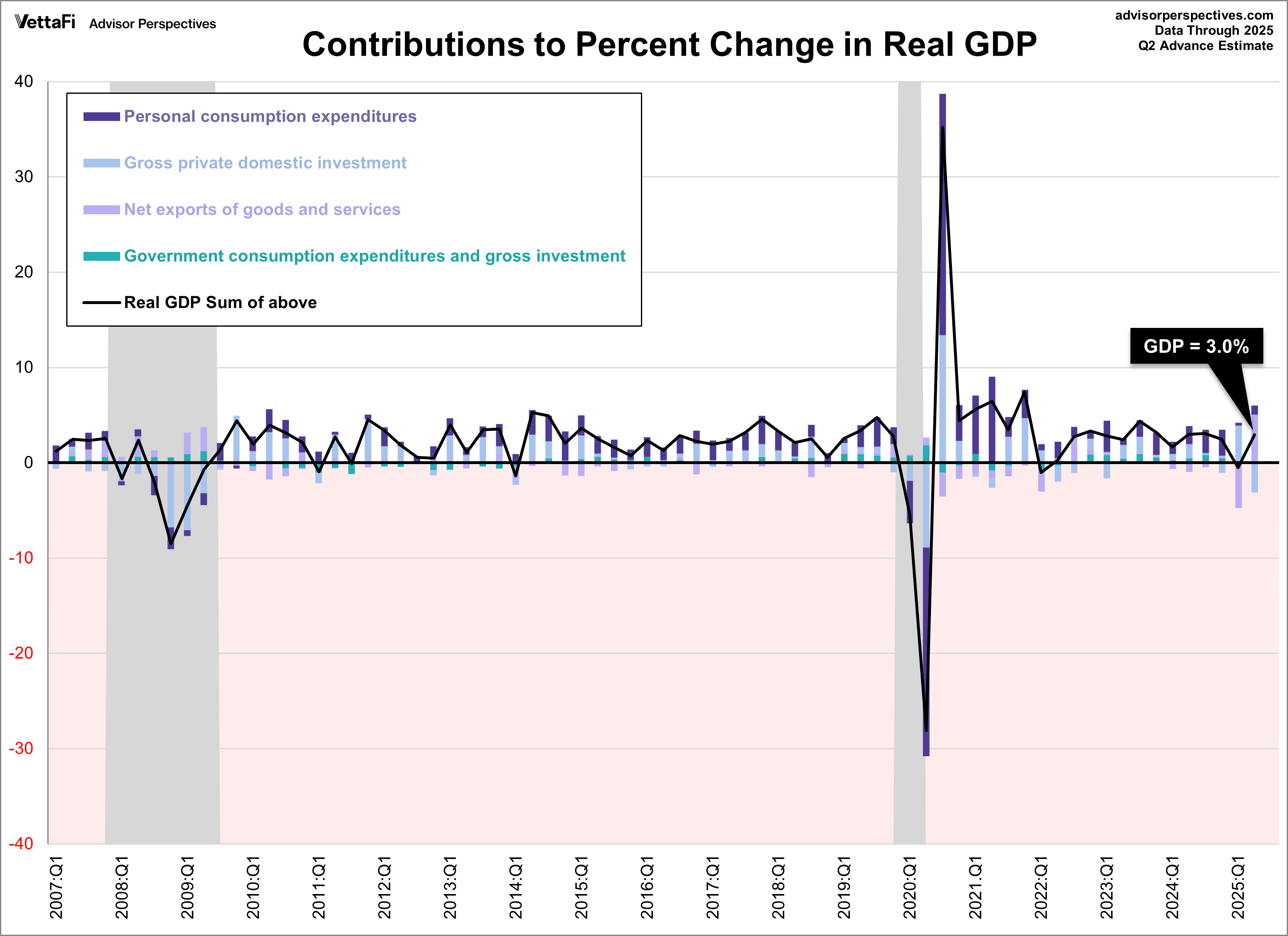Written by Jill Mislinski and Steven Hansen

The third estimate of first quarter 2017 Real Gross Domestic Product (GDP) was revised upward to 1.4 %. This improvement was mainly due to lower inflation numbers relative to the second estimate.
Analyst Opinion of GDP
Not sure the inflation change is real – but overally the first quarter is now better than the previous quarter using year-over-year analysis.
The market expected:
| Seasonally Adjusted Quarter-over-Quarter Change at annual rate | Consensus Range | Consensus | Advance Actual | 2nd Estimate Actual | 3rd Estimate Actual |
| Real GDP | 0.9 % to 1.5 % | 1.2 % | +0.7 % | +1.2% | +1.4 % |
| GDP price index | 2.2 % to 2.2 % | 2.2 % | +2.3 % | +2.2 % | +1.9 % |
| Real Consumer Spending | 0.5 % to 0.9 % | 0.6 % | +0.4 % | +0.6 % | +1.1 % |
- Headline GDP is calculated by annualizing one quarter’s data against the previous quarters data. A better method would be to look at growth compared to the same quarter one year ago. For 1Q2017, the year-over-year growth is now 2.1 % – up marginally from 4Q2016’s 2.0 % year-over-year growth. So one might say that the rate of GDP growth improved from the previous quarter.
Real GDP Expressed As Year-over-Year Change

The same report also provides Gross Domestic Income which in theory should equal Gross Domestic Product. Some have argued the discrepancy is due to misclassification of capital gains as ordinary income – but whatever the reason, there are differences.
Real GDP (blue line) Vs. Real GDI (red line) Expressed As Year-over-Year Change

This third estimate released today is based on more complete source data than were available for the “second” estimate issued last month. (See caveats below.)
Real GDP is inflation adjusted and annualized – the economy improved on a per capita basis.
Real GDP per Capita

The table below compares the previous quarter estimate of GDP (Table 1.1.2) with the advance estimate this quarter which shows:
- consumption for goods and services decelerated..
- trade balance improved and increased GDP by 0.2% (imports grew and exports declined)
- inventory change removed 1.1 % to GDP
- except for inventory growth, fixed investment growth improved
- there was a decline in federal spending removing 0.2 % from GDP
The following is Table 1.1.2 before the annual revision: [click to enlarge]

What the BEA says about the third estimate of GDP:
Real gross domestic product (GDP) increased at an annual rate of 1.4 percent in the first quarter of 2017 (table 1), according to the “third” estimate released by the Bureau of Economic Analysis. In the fourth quarter of 2016, real GDP increased 2.1 percent.
The GDP estimate released today is based on more complete source data than were available for the “second” estimate issued last month. In the second estimate, the increase in real GDP was 1.2 percent. With the third estimate for the first quarter, personal consumption expenditures (PCE) and exports increased more than previously estimated, but the general picture of economic growth remains the same
Inflation continues to moderate as the “deflator” which adjusts the current value GDP to a “real” comparable value continues to moderate. The following compares the GDP implicit price deflator year-over-year growth to the Consumer Price Index [this puts both on the same basis for comparision]:

What the BLS says about the revision from the second to the third estimate:
The upward revision to the percent change in real GDP primarily reflected upward revisions to PCE and to exports which were partly offset by a downward revision to nonresidential fixed investment.

In the same release, corporate profits data was released showing less growth.
Profits from current production (corporate profits with inventory valuation adjustment and capital consumption adjustment) decreased $48.4 billion in the first quarter, in contrast to an increase of $11.2 billion in the fourth quarter.
Profits of domestic financial corporations decreased $27.9 billion in the first quarter, in contrast to an increase of $26.5 billion in the fourth. Profits of domestic nonfinancial corporations decreased $11.1 billion, compared with a decrease of $60.4 billion. The rest-of-the-world component of profits decreased $9.4 billion, in contrast to an increase of $45.1 billion. This measure is calculated as the difference between receipts from the rest of the world and payments to the rest of the world. In the first quarter, receipts increased $5.3 billion, and payments increased $14.7 billion.

Overview Analysis:
Here is a look at Quarterly GDP since Q2 1947. Prior to 1947, GDP was an annual calculation. To be more precise, the chart shows is the annualized percentage change from the preceding quarter in Real (inflation-adjusted) Gross Domestic Product. We’ve also included recessions, which are determined by the National Bureau of Economic Research (NBER). Also illustrated are the 3.21% average (arithmetic mean) and the 10-year moving average, currently at 1.40%.
Here is a log-scale chart of real GDP with an exponential regression, which helps us understand growth cycles since the 1947 inception of quarterly GDP. The latest number puts us 15.0% below trend.
A particularly telling representation of slowing growth in the US economy is the year-over-year rate of change. The average rate at the start of recessions is 3.35%. Eight of the eleven recessions over this timeframe have begun at a higher level of current real YoY GDP.
In summary, the Q1 GDP Third Estimate of 1.4% was better than forecast, but still below the 2.1% GDP for the previous quarter.
The chart below is a way to visualize real GDP change since 2007. The chart uses a stacked column chart to segment the four major components of GDP with a dashed line overlay to show the sum of the four, which is real GDP itself. As the analysis clear shows, personal consumption is key factor in GDP mathematics.
Caveats on the Use of Gross Domestic Product (GDP)
GDP is market value of all final goods and services produced within the USA where money is used in the transaction – and it is expressed as an annualized number. GDP = private consumption + gross investment + government spending + (exports − imports), or GDP = C + I + G + (X – M). GDP counts monetary expenditures. It is designed to count value added so that goods are not counted over and over as they move through the manufacture – wholesale – retail chain.
The vernacular relating to the different GDP releases:
“Advance” estimates, based on source data that are incomplete or subject to further revision by the source agency, are released near the end of the first month after the end of the quarter; as more detailed and more comprehensive data become available, “second” and “third” estimates are released near the end of the second and third months, respectively. The “latest” estimates reflect the results of both annual and comprehensive revisions.
Consider that GDP includes the costs of suing your neighbor or McDonald’s for hot coffee spilled in your crotch, plastic surgery or cancer treatment, buying a new aircraft carrier for the military, or even the replacement of your house if it burns down – yet little of these activities is real economic growth.
GDP does not include include home costs (other than the new home purchase price even though mortgaged up the kazoo), interest rates, bank charges, or the money spent buying anything used.
It does not measure wealth, disposable income, or employment.
In short, GDP does not measure the change of the economic environment for Joe Sixpack, and Joe Sixpack’s kid, yet pundits continuously compare GDP across time periods.
Although there always will be some correlation between all economic pulse points, GDP does not measure the economic elements that directly impact the quality of life of its citizens.
include(“/home/aleta/public_html/files/ad_openx.htm”); ?>











